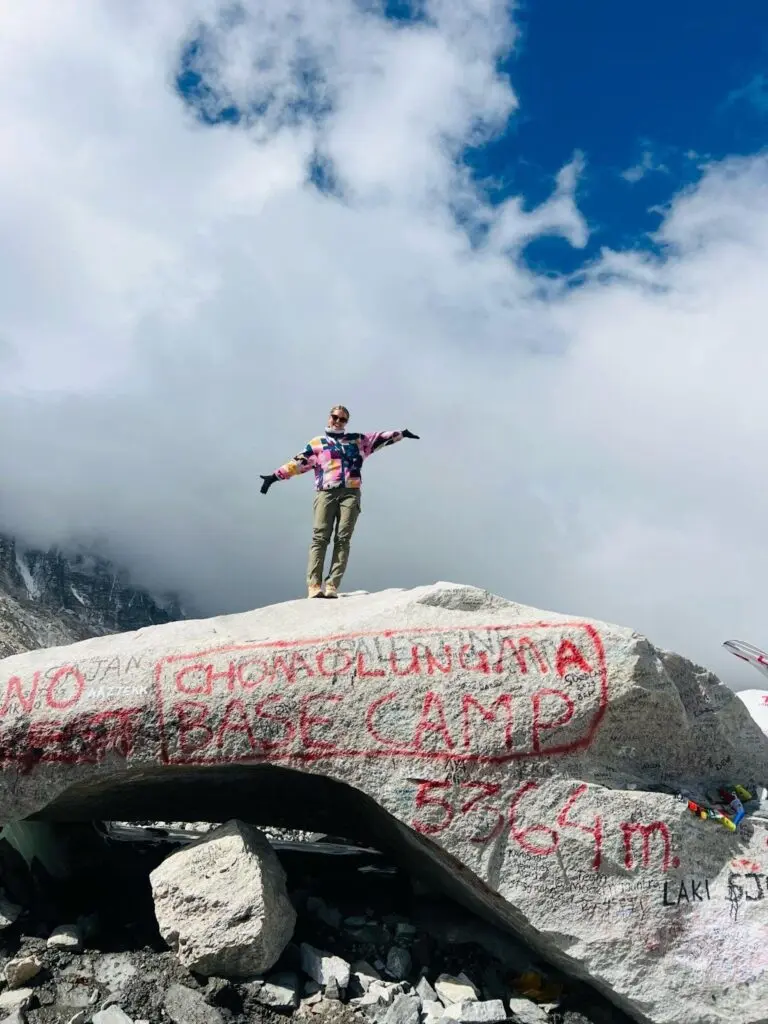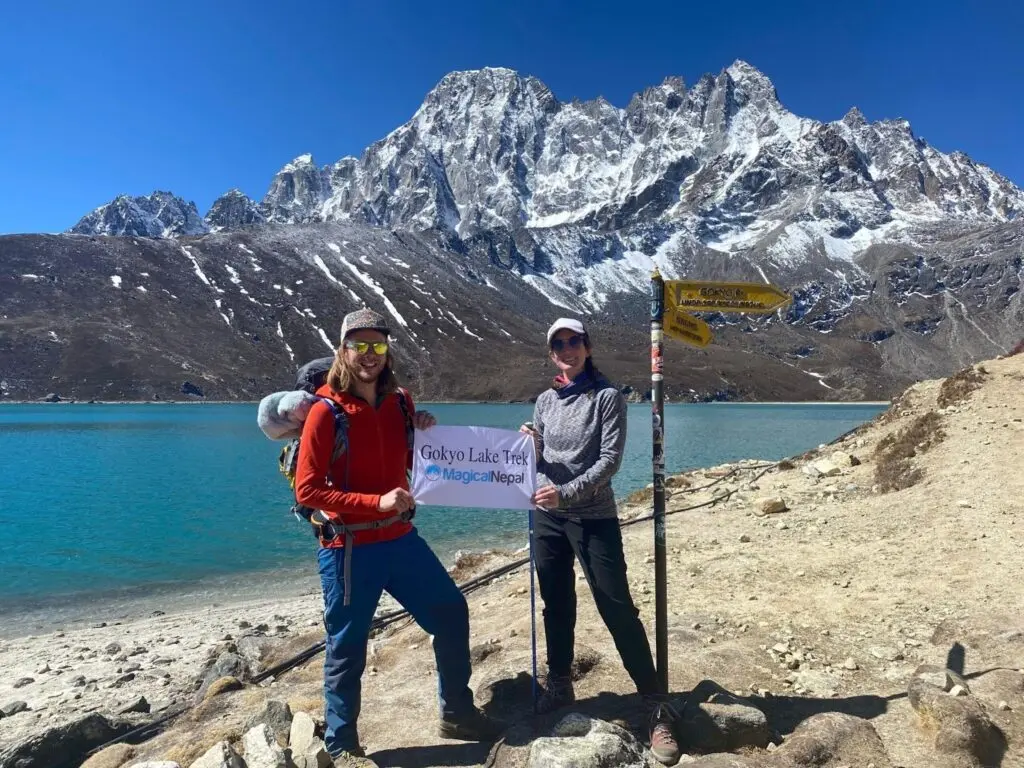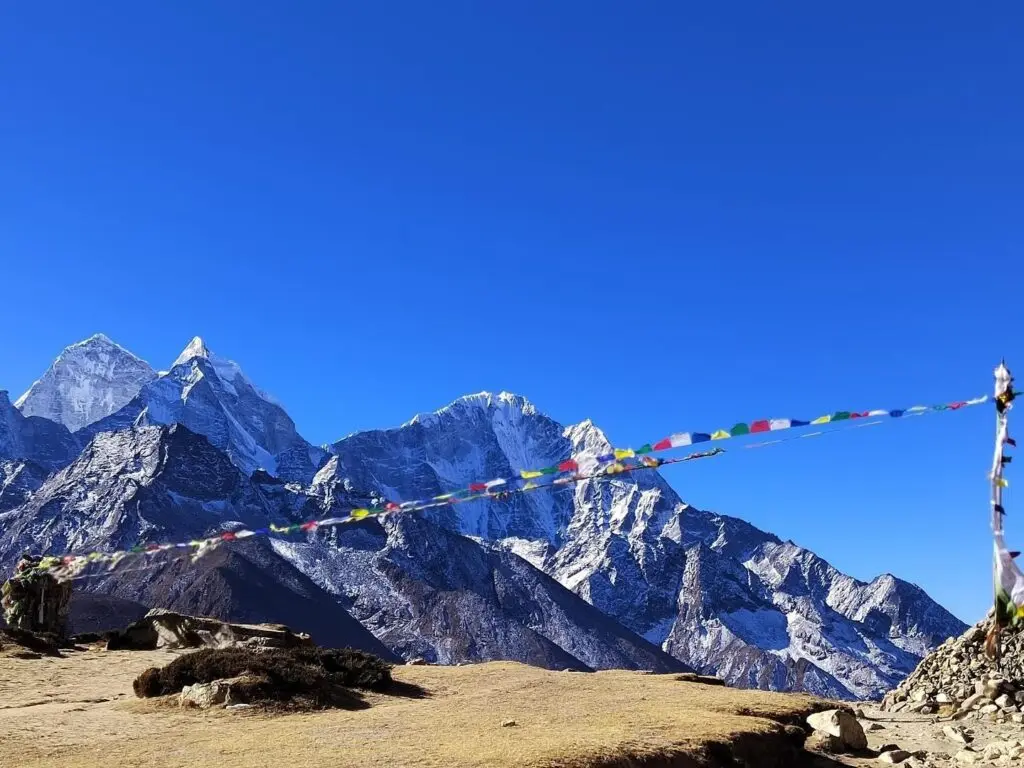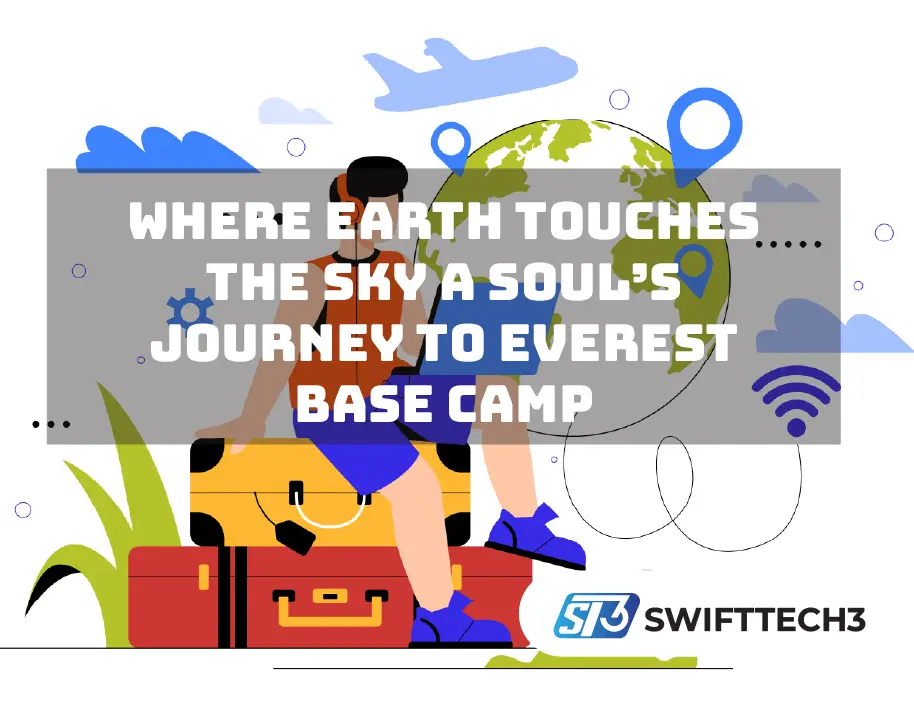There are places in the world that whisper to you, and then there are places that roars. The Everest Base Camp trek is is one of those thunderous call — a jurney that demands not just curiosity, but committment. It’s a path carved by centurys of Sherpa footsteps, by the ice and wind that shape the Khumbu, and by the dreams of trekkers who long to stand in the shadow of the world tallest peak.
Everest, or Chomolungma — “Mother Godess of the World” — needs no introduction. Yet the path that leads to her base is not just a trail; it’s a pilgramage. It’s about walking through the heart of Nepel, where prayer flags flutter over suspension briges, and where every breath at altitude feels both like a battle and a blessing.
This is not merely a trek. It’s a slow unspoling of your limits, a meditation in motion — and for many, a rediscovery of self at 5,364 meter above sea level.
The Jurney Begins: Flying into the Khumbu
Every great adventure starts with a leap — and in the case of Everest Base Camp, it’s a leap of faith into the short, nerve-ratling runway of Lukla. Known as one of the world most thrilling airstrips, the 30-minutes flight from Kathmandu to Lukla sets the tone: the mountains are majestic, but they demands respect.
Lukla, perched at 2,860 meters, is more than a gateway; it’s the first handshake with the Khumbu region. The air is thiner, cleaner, and tinged with insence from near by monasterys. Yaks jingle pass carrying supplys, trekkers shuffle through tea house doors for there first cup of lemon giner tea, and the thrill of begining fills the narrow streets.
From here, the trail unferls like a ribon through pine forrests and across swinging briges draped in prayer flags. Rivers born from glaicers roar below, and every bend opens to new vistas of snow claded peaks.
The early days — from Lukla to Phakding, and then to Namche Bazzar — are the gentle introdction, though “gentle” is relative. The path undulate relentlesly, and every climb is a reminder: the Himalya gives nothing for free.
Namche Bazzar: The Sherpa Captial of the World
Namche Bazzar (3,440 m) is more then a stopover; it’s the beating heart of the Khumbu. Shaped like an ampthitheater carved into the mountain side, it’s where trekkers rest, acclimitize, and glimpse their first view of Everest if the wheather smiles.
This vibrant town hum with energy — bakeries serve apple pie beside yak-wool shop, Wi-Fi cafes buzzing with trekkers shareing updates, and monasterys echo with chants that have floated over these hill for genrations.
Acclimitization here is vitel. The mantra “climb high, sleep low” define the rythm. A populer acclimitization hike takes you to the Everest View Hotel, offering your first real panaroma of the giants: Everest, Lhotse, Nuptse, and Ama Dablam — the most gracefull of them all.
But Namche is not just a way point — it’s a lesson in Sherpa resiliance and hospitility. These mountain peoples, fammed for there strength and serenety, have balanced ancient Budhist traditions with the demand of modern tourism. To share tea with a Sherpa elder is to sip from a deep well of humbleness.
The Trail of Temples and Thunder: Namche to Tengboche

Leaving Namche, the path wind through rhodendron forrests that blaze pink and red in spring, with Himlayan monals darting betwen the trees. The air grow sharper as you aproach Tengboche (3,867 m), home to the iconnic Tengboche Monastry — the spirital center of the Khumbu.
Few places on earth blends natural and spirital granduer like this. The monastry, framed by Everest, Lhotse, and Ama Dablam, feels suspanded between heaven and earth. Monks in crimsom robes chant prayrs as insence curl into the mountain air, offering blessngs not just to climbers but to all who pass.
If your lucky, you will arrive during evening puja — the rythmic beating of drums, the low murmer of mantras, and the deep vibartion of horns fill the hall. Even the most skeptic trekkers finds themself stilled, as if the Himlaya itself were breathing through those sacred walls.
Outside, as the sun dips, Ama Dablam glows golden — a godess watching over all who dare to walk her vally.
Into the Thin Air: Dingboche, Lobuche, and the Climb Beyond Comfort
From Tengboche, the landscape shift dramaticly. The forrests gives way to scrub and stones, and every step upward feels like pealing away layers of the known world. The trail to Dingboche (4,410 m) wind through the village of Pangboche — home to ancint mani walls carved with Budhist prayers — before open into wide vallys sweeped by icey winds.
By the time you reach Dingboche, oxgyen level have droped to roughly 60% of sea level. Even simple task — ziping a jacket, brushing teeth — feels like efforts. Acclimitization become more then a guideline; it’s a survivel tool. A second rest day here, with short hikes up Nangkartshang Hill, help the body adapts.
The nights are colder, the stars sharpper. You begin to notice your heart beat echo in your ear as you lie awake — a rythmic remind that your body is fight, adapting, surviveing.
From Dingboche to Lobuche (4,940 m), the trail climb steadly through the windswept morain of the Khumbu Glacier. Enroute lies the Thukla Pass, a place of quite revrence where memorials honor climbers who never return from Everest higher reaches. Among the fluttring flags and stone cairns, names like Scot Fisher and Rob Hall remind you that ambiton and humility must walks hand in hand here.
By now, conversatons among trekkers slow. Every breath is presious. The laughter of earlyer days gives way to a shared silance — the unspoken understanding of what altitude does to mind and boddy.
The Final Push: Gorak Shep and Everest Base Camp

Gorak Shep (5,164 m) is the last settelment before Base Camp — a baren outpost on a frozen lake bed, surounded by peaks that seems to pierce the stratospher. The air is thinn, the landscape looks aliean, and excitment tinged with exhauston hums through every logde.
From here, the path to Everest Base Camp is both exhilirating and gruling — a slow steady march along the edge of the Khumbu Glacier. The ground crunch beneath your boots, the wind howel, and ahead, the black piramid of Everest looms behind the jagged wall of Nuptse.
After hours of steady effort, the prayer-flag coverd cairns of Base Camp comes into view. There’s no single grande moment — no Everest summit, no sweepng view of the peak itself — but the emotion hit hard. This is where expeditons begins, where climbers steel themself for their date with destiny.
Standing here, surounded by icefalls and bannners left by those who dared higher, you feel the weight of histroy. Every trekker — from the weekend advnturer to the lifetime mountaneer — knows they’ve arived at something profound.
It’s not just about reaching Base Camp. It’s about what it took to get there — the patince, persistance, and humbleness demanded by evry step.
Kala Patthar: Touching the Sky
For many, the true climax of the journy comes the next moring. Before dawn, trekkers climbs Kala Patthar (5,545 m) — “Black Rock” — for the best possibel view of Everest. It’s a steep, breath stealing ascent in the icey dark, with headlamps bobing like fireflys up the slope.
Then, as the first ray of sunlite hits the summit of Everest, the world turn gold. The peak glows like a flame, and sudenly every strugle — every breathless night, every aching mussle — feels worth it.
This is the moment trekkers dreams of: standing at the roof of the world, the Himalya stretched endlesly in all direction. You may not be at the summit, but in your heart it feels just as high.
Descent: The Journey Homeward
The return jorney often goes more faster, but it’s no less meaninful. Decending from altitude brings back strenght and apetite, and villages that once seems austere feel welcomeing again.
In Pheriche, trekkers gather in warm logdes, sharing stories over steeming plates of dal bhat — Nepal’s nationel comfort food. By the time you’re back in Namche, a bakery’s cinamon roll feels like a feist.
Yet the mountans changes you. The physical hardhip, the daily rythem of walkng, the quiet hours betwen peaks — they etchs something deep. By the time you board the flight back to Kathmando, you’ve leaved a part of yourself behind in the Khumbu.
The Culture of the Khumbu: Beyond the Trail
To trek in the Everest region is to walks through a liveing museam of Sherpa culture. The peoples here — descendents of Tibetan highlenders — have build lifes in conditions that most would finds imposible. Their villages clings to cliff sides; their prayrs are carved into stones.
Every mani wall, chorten, and fluttring flag tells a storie of devotion. Budhism infuse daily life, from the spin of prayer wheels to the butter lamps flicking in home alters. It’s a spiritaulity that feels inseprable from the mountans themselfs.
Sherpa hospitallity is legandary — a warm smile, endless cup of tea, and an unspoked code of kindnes that binds travllers together. In a world often obsseced with speed and sucess, the Sherpa way is a lessson in simplicity and ballance.
Preparation: Body, Mind, and Gear

The Everest Base Camp trek is not technicle — no ropes or ice axes required — but it is demanding. Trekkers need a good level of fitnes, strong legs, and even stronger determnation.
Training:
Three to four month of preperation helps imensly. Focus on cardio endurence (running, hikeing, stair climbng) and strenght (especialy for legs and core). Simulate long days of walking with a backpack, ideally with elevetion gain. Remember: it’s not a race. Consistancy trumps intensity.
Gear:
Layering is key. Whether changes quickly — mornings can starts below freezing and ends in sunshine. A typical packing list include:
- Down jaket and thermal base layers
- Wind proof shell
- Trekking poles
- Sturdy, broken-in boots
- Sleeping bag rated to atleast -15°C
- Water purificaton tablets or filter
- Sunscrean, lip balm, and sun glasses (the sun at altitude is brutal)
Most gears can be rented or purchesed in Kathmando or Namche, but qualty varies. Invest in relieable foot wear — your feets will carry your dreams.
Permits and Logestics:
Trekkers need two main permit:
- The Sagarmatha National Park Enrty Permit
- The Khumbu Pasang Lhamu Rural Municapility Permit
Most organzied treks handle these, but independant trekkers must obtain them on route (in Lukla or Monjo).
Altitude and Acclimatization: Respecting the Mountain
Altitude sicknes is the invisble challange of the EBC trek. Above 2,500 meter, the air thins, and oxygen level drops dramaticaly. Even the fitest trekkers can suffers if they ascend too quick.
The golden rule: “Trek high, sleep low.”
Allow atleast two acclimatizaton days — typicaly in Namche and Dingboche. Symtoms like head ache, nausea, or insomia should be treat seriously. Diamox (acetozolamide) can helps, but hydraton, slow paceing, and rest are your best defence.
In the Khumbu, humbleness is survivel. Those who ignore the altitude often finds themself turned back by their own bodys.
Seasons of the Himalya
Timing is everything. The best treking season are pre-monsoon (March–May) and post monsoon (September–November).
Spring brings blooming rhododedrons and clear sky. The trails buzz with energy, and Base Camp is filled with climbers prepairing for summit attemps.
Autumn offer the crispest visiblity, with crystal clear morings and fewer wether distruptions.
Winter (December–Febuary) is stunning but biterly cold, while the monsoon months (June–August) cloaks the mountans in mist and leaches.
Each season paints the Khumbu in diffrent hues — from the flower filled trails of April to the frost silverd morings of Octobar.
Costs and Comforts
A trek to Everest Base Camp typicaly takes 12–14 days and cost anywere from $1,200 to $3,000 USD, depending on whether it’s guided or indepndent.
Accomodation:
Tea houses are the soul of the EBC trail — family run lodges offering simple rooms, hearty meals, and mountan camaradry. A typical room have twin beds, a shared toliet, and, if you lucky, a warm stove in the dinning room. Hot showers and charging outlet often come at extra fee.
Food:
Menus are surprsingly varied — from dal bhat (rice and lentil) to pasta and panckes. Yet, the golden rule applies: eat local, eat fresh. Dal bhat power, as the saying goes, “24 hour no shower.”
Why Everest Base Camp Matters
What makes the Everest Base Camp trek so tranformative isn’t just it’s physical challange or the grandure of the mountans — it’s the journy inward.
You start as a travler; you end as a pilgrim. The trail strip away the noise of modern life. Up here, your world narow to the essencials — breath, step, horizon. The mountans becomes mirrors, reflecting both your fragilty and your strenght.
Every trekker reach a moment — maybe at Base Camp, maybe watching dawn from Kala Patthar — when they relize: the summit was never the goal. The journy itself was a gift.
Practical Tips from the Trail
- Go Slow: Altitude reward patince. Let other rush — your lung will thank you.
- Hydrate Relentlesly: Aim for 3–4 litter of water daily. Dehydration worsens altitute symptons.
- Bring Cash: ATM’s disapear after Namche, and card paymants are unreliabel.
- Respect the Culture: Walk clock wise around stupas, spin prayer wheels to your right, and never point your feets toward shrine.
- Stay Flexble: Weather, health, or logestics may force changes. The mountan set the pace.
- Disconect to Connect: Internet access fades with altitute — and that’s a gift. Let the silence of Himalya be your companian.
The Return to the World
Back in Kathmando, amid the chaotik hum of trafic and incense fill temples, you might catch yourself longging for the rhytm of the trail — for the crunch of boots on rocks, the laughter of porters, the sight of clouds wraping around Ama Dablam.
The Everest Base Camp trek doesn’t ends when you leave the mountans; it lingers. It reshape your sense of distence, endurance, and wonder.
In a world obssesed with speed, the trek teach slowness. In a culture of consumtion, it teach gratitued. And in the face of Everest, it remind you that awe is not a luxry — it’s essential.
Final Reflection: The Mountain Within
Every step to Base Camp is a step inwards — toward patince, humility, and present. The trek’s physical destnation is just a point on map; its true summit lies in the quiet tranformation that unfold within.
As Sir Edmund Hillary, who first stood atop Everest, once said, “It is not the mountan we conquer, but ourselfs.”
So when you finaly turn your back on the Himalya, rember: the trail never truely leave you. Somewere, deep inside, a part of you will always be walkng toward Everest — steady, breath by breath, where earth touch the sky.

FAQ’s
Usualy, the trek takes around 12 to 14 days, depend on your pace and route. Some trekkers go little faster, but rushing can cause altitude problems. Taking your time helps you enjoy the trail and stay safe.
No, you don’t need to be a expert climber. The trek isn’t technicle, but you should be in good shape and ready for long walks and thin air. A few month of training before going makes a big differnce in comfort and safety.


